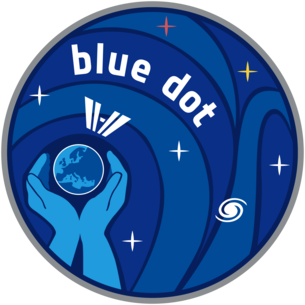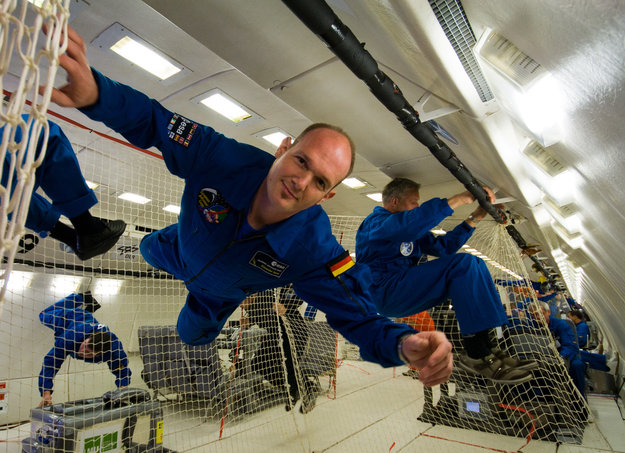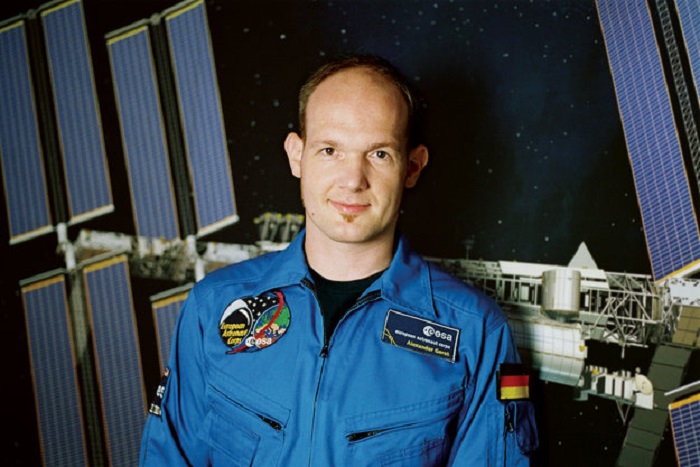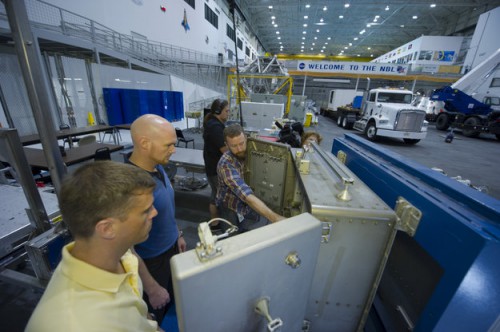,
22.09.2013

ESA astronaut Alexander Gerst is set for a six-month stay on the International Space Station in 2014. His mission came one step closer today when the mission patch was revealed at the European Astronaut Centre during German Space Day in Cologne, Germany.
Alex is leaving Earth from Baikonur cosmodrome in Kazakhstan 28 May 2014. He will fly on a Soyuz spacecraft to the International Space Station with Russian cosmonaut Maxim Viktorovich Surayev and NASA astronaut Gregory Reid Wiseman.
The mission logo is inspired by an image of Earth taken by NASA’s Voyager spacecraft as it travelled six billion kilometres from our planet. American astronomer Carl Sagan described our faintly visible planet on the photograph as “a pale blue dot”.
During his 166-day mission the next ESA astronaut to fly to space has an extensive scientific programme planned running around 40 experiments in materials physics, human physiology, radiation biology, solar research, biotechnology, fluid physics, astrophysics and technology demonstrations. All experiments are designed to improve life on Earth and prepare further exploration projects.
A highlight of Expedition 40/41 is the electromagnetic levitator furnace which keeps molten metal suspended in microgravity for measurements. On Earth many readings in furnaces are hampered by the mold holding the metal so characteristics cannot be analysed without interference. The results of this experiment promise to improve industrial casting processes and might allow for more delicate and fine castings.
After conquering remote mountains and working in Antarctica, the geophysicist and volcanologist will become the third German to visit the Station. His mission has the theme ‘shaping the future’ and will include an educational programme to inspire the next generation of engineers and scientists.
.

Alex during weightlessness training
.

ESA PR 23 2011 - ESA astronaut Alexander Gerst has been assigned to fly to the International Space Station on a 6-month mission in 2014, serving as a flight engineer for Expeditions 40 and 41.
Alexander is the second of the new group of European astronauts, which graduated last November, to be assigned to a mission.
He will be launched aboard a Russian Soyuz spacecraft from Baikonur Cosmodrome in Kazakhstan in May 2014, returning to Earth in November 2014.
Today is an ideal day for the announcement: the European Astronaut Centre in Cologne has been buzzing with activity as around 100 000 visitors mingle on German Aerospace Day.
After conquering remote mountains and working in Antarctica, the 35year-old geophysicist and volcanologist will become the third German to visit the Station.
He will be accompanied by Russian Fyodor Yurchikhin, as Soyuz commander, and NASA astronaut G. Reid Wiseman.
Cosmonauts Alexander Skvortsov and Oleg Artemyev and NASA astronaut Steven Swanson will also share part of the mission with Alexander as members of Expeditions 39 and 40.
Alexander’s flight will be the sixth long-duration mission for an ESA astronaut.
“ESA Member States have decided to extend their support to the exploitation of the International Space Station up to 2020,” said Thomas Reiter, ESA’s Director for Human Spaceflight and Operations.
“The appointment of the new group of European astronauts to long-duration missions reflects the commitment of Member States.
“Alexander Gerst will pursue the European goals in a long fruitful German tradition.
.
Alexander Gerst was born in Künzelsau, Germany, on 3 May 1976. His favourite sports are fencing, swimming and running. He especially enjoys outdoor activities such as skydiving, snowboarding, hiking, mountaineering, climbing and scuba diving.
Education
Alex graduated from the Technical High School in Öhringen, Germany, in 1995.
In 2003 he received a diploma in geophysics from the University of Karlsruhe, Germany, and a master’s degree in Earth sciences from the Victoria University of Wellington, New Zealand. Both degrees were awarded with distinction.
In 2010 Alex graduated with a Doctorate in Natural Sciences at the Institute of Geophysics of the University of Hamburg, Germany. His dissertation was on geophysics and volcanic eruption dynamics.
Organisations
Alex is a member of
- The International Association of Volcanology and Chemistry of Earth’s Interior (IAVCEI)
- The German Geophysical Society (DGG)
- The European Geosciences Union (EGU)
- The European Volcanological Society (SVE)
- The American Geophysical Union (AGU)
Experience
During school, Alex volunteered as a boy scout leader, fire-fighter and water rescue lifeguard. As a student, from 1998 to 2003 he participated in various international scientific collaborations and field experiments. Several of these expeditions led him to remote locations such as Antarctica where he installed scientific instruments.
From 2001 to 2003, researching his master’s thesis on a volcano in New Zealand, Alex developed new volcano monitoring techniques that might improve forecasts of volcanic eruptions. The results were published inScience Magazine.
Alex worked on developing scientific instruments at the Institute of Geophysics at the University of Hamburg between 2004 and 2009.
From 2005 to 2009, whilst at the Institute of Geophysics, he also worked towards his doctorate, investigating volcanic eruption dynamics on active volcanoes. His research goal was to determine the mechanics and the energy released during the first seconds of a volcanic eruption. His research led him to visit volcanoes on all continents, concentrating on an active volcano in Antarctica. In 2007 Alex received the Bernd Rendel award for outstanding research from the DFG German Research Foundation.
Alex was selected as an ESA astronaut in May 2009. He joined ESA in September 2009 and completed Astronaut Basic Training in November 2010.
In September 2011, Alex was assigned to fly to the International Space Station on a six-month mission. He will serve as a flight engineer for Expeditions 40 and 41. He will be launched on a Soyuz spacecraft from the Baikonur Cosmodrome in Kazakhstan in May 2014, returning to Earth in November 2014. His comprehensive research programme will include a wide variety of European and international science experiments.
.
Quelle: ESA
.
Update: 4.10.2013
.
Blue Dot Worker: Germany's Third ISS Crewman Prepares for May 2014 Launch
Twenty-three years ago, on 14 February 1990, one of the most remarkable photographs of our age was taken. At a distance of almost 5.9 billion miles from Earth – and way beyond the orbit of Neptune – NASA’s Voyager 1 spacecraft acquired 64 images and captured a unique family portrait of six of the nine planets in our Solar System. Included in the portrait was a distant, pale blue speck that we call home. Carl Sagan later referred to it as the “Pale Blue Dot” and the phrase has since become a byword for the smallness and insignificance of our place in the cosmos. Fittingly, the European Space Agency (ESA) recently announced that Germany’s Alexander Gerst – its next long-duration occupant of the International Space Station (ISS) – will fly a mission known as “Blue Dot”.
The announcement and the image of Gerst’s mission patch for Expedition 40/41 was revealed at the European Astronaut Centre during German Aerospace Day in Cologne, Germany, on 22 September. ESA noted that the Blue Dot patch “is inspired” by the Voyager 1 family portrait. The circular, deep blue emblem pays homage to the ISS and its goal of understanding, protecting and advancing life on Earth. “During his 166-day mission, the next ESA astronaut to fly to space has an extensive scientific program planned,” it was explained, “running around 40 experiments in materials physics, human physiology, radiation biology, solar research, biotechnology, fluid physics, astrophysics and technology demonstrations. All experiments are designed to improve life on Earth and prepare further exploration projects.”
German Aerospace Day was also selected back in September 2011 to announce Gerst’s assignment to this mission, which will make him only the third of his countrymen to voyage to the ISS. Previously, Thomas Reiter – who today serves as ESA’s Director of Human Spaceflight and Operations – flew a 171-day mission in July-December 2006, becoming the first European astronaut to participate in a long-duration flight to the multi-national orbital outpost. More recently, Hans Schlegel flew aboard STS-122, the February 2008 Shuttle mission which delivered Europe’s Columbus laboratory module to the station. More than six years later, Gerst will pick up the baton for German astronauts in space. Unlike Reiter and Schlegel, however, this will be his first space mission.
Liftoff of Soyuz TMA-13M is presently scheduled for 28 May 2014, carrying Gerst, together with Russian cosmonaut Maksim Surayev and NASA astronaut Reid Wiseman. The crew will join Expedition 40 and will later transfer to become the Expedition 41 “core” crew in the last part of their mission. With Reisman also making his first flight, only Surayev is flight-experienced, having served on Expedition 21/22 in September 2009-March 2010. He spent a total of 169 days in orbit. In the aftermath of his first mission, Surayev briefly entered the headlines in the summer of 2010, when the Defence Ministry reportedly twice denied his nomination for the Hero of Russia accolade. This prompted the Russian Federal Space Agency to successfully appeal directly to President Dmitri Medvedev and Surayev duly received the honor in December 2010.
In February 2011, Surayev was assigned to fly with NASA astronaut Karen Nyberg and Italy’s Luca Parmitano on Expedition 36/37 and in September 2011 Russian cosmonaut Fyodor Yurchikhin was named to join Gerst and Wiseman on Expedition 40/41. However, at the end of 2011, it would appear that Surayev was grounded and replaced by Yurchikhin. It was noted at the time that Surayev unsuccessfully sought election to the Russian Duma and was subsequently reassigned to the Expedition 40/41 slot. As a result, in effect, Yurchikhin and Surayev swapped missions.
Assuming an on-time liftoff of Soyuz TMA-13M with Surayev, Gerst and Wiseman, it is likely that a four-orbit “fast rendezvous” profile will be adopted to enable the crew to reach the space station about six hours after leaving Baikonur. They will initially join Expedition 40 crewmen Steve Swanson of NASA and Russian cosmonauts Aleksandr Skvortsov and Oleg Artemyev for the first few months of their mission. Throughout the summer of 2014, they will welcome numerous Visiting Vehicles from both the International Partners and NASA’s Commercial Resupply Services (CRS) partners, SpaceX and Orbital Sciences Corp. ESA is scheduled to fly its fifth and last Automated Transfer Vehicle (ATV-5) – named in honor of Belgian astronomer Georges Lemaître – from June-December 2014, with Japan’s fifth H-II Transfer Vehicle (HTV-5) due to follow in July-August.
With Orbital’s first dedicated Cygnus mission under its CRS contract with NASA presently targeted for launch in early December 2013 – and known as “ORB-1″ – the company has plans to launch two more cargo ships (ORB-2 and ORB-3) to the ISS in May and October 2014. Meanwhile, it was reported by NASASpaceflight.com that SpaceX will stage its third dedicated CRS Dragon mission (known as “CRS-3″) in February 2014, followed by two others (CRS-4 and CRS-5) in April and August. Russian Progress cargo ships are expected to launch toward the ISS every 2-3 months throughout 2014, with missions tentatively planned for February, April, July and October.
Of particular note is the arrival of Russia’s long-awaited Multi-Purpose Laboratory Module (MLM), whose launch was originally expected in December 2013, but which is not expected until at least April or as late as September 2014. If the MLM launches in April, it can be expected that as many as nine EVAs from the Russian segment of the station may be conducted between June and October to outfit the new module and configure it with the rest of the station.
Midway through the expedition of Surayev, Gerst and Wiseman, the “core” Expedition 40 crew of Swanson, Skvortsov and Artemyev will return to Earth in mid-September at the end of their six-month flight. At this stage, Swanson will hand command of the ISS over to Surayev and Expedition 41 will commence. Two weeks later, three new arrivals – the Soyuz TMA-14M crew of Russian cosmonauts Aleksandr Samokutyayev and Yelena Serova, together with NASA astronaut Barry Wilmore – will arrive to form the second half of Expedition 41. Finally, on 10 November 2014, Surayev, Gerst and Wiseman will board Soyuz TMA-13M and undock from the station, which will have been their home for almost half of the year. They will touch down a few hours later on the barren steppe of Kazakhstan, concluding a mission of about 166-167 days in orbit.
Selected as one of six European astronaut candidates in May 2009 – together with Italy’s Luca Parmitano and Sam Cristoforetti, France’s Thomas Pesquet, Britain’s Tim Peake and Denmark’s Andreas Mogensen – Alexander Gerst will become the 11th astronaut of German nationality to fly into space. Back in August 1978, “East German” cosmonaut Sigmund Jähn flew with Soviet crewmate Valeri Bykovsky aboard Soyuz 31 to the Salyut 6 space station and in November 1983 “West German” astronaut Ulf Merbold was a payload specialist aboard Shuttle mission STS-9, the first Spacelab flight.
Interestingly, Merbold – though “West German” by nationality and political status in his early years – was actually born in Greiz, Thuringia, less than 25 miles from the birthplace of Sigmund Jähn. Both spent their formative years in the communist-led East Germany, but after finishing high school in 1960 – not long before the erection of the Berlin Wall – the young Merbold was one of thousands who defected to the democratic West Germany. Ahead of the collapse of the Wall, two more “West German” astronauts, Reinhard Furrer and Ernst Messerschmid, flew aboard the Shuttle’s Spacelab-D1 mission in October 1985.
After reunification, other Germans followed. Merbold became the first German to fly two, and later three, space voyages, participating in the STS-42 Spacelab mission in January 1992 and a 30-day flight to Russia’s Mir space station in October-November 1994. Klaus-Dietrich Flade flew a short mission to Mir in March 1992 and Reinhold Eward spent three weeks aboard the station in February 1997. Thomas Reiter became the first German to undertake a long-duration mission and a spacewalk, flying for 179 days to Mir in September 1995-February 1996, and is presently the most flight-experienced German astronaut, having also flown a 171-day ISS expedition in July-December 2006. The latter mission made Reiter the first ESA astronaut to fly a long-duration ISS expedition.
Other German astronauts have included Hans Schlegel and Ulrich Walter, who served as payload specialists on the Spacelab-D2 mission in April 1993. Schlegel was later selected for mission specialist training and in February 2008 – aged 56, which makes him the oldest German astronaut to date – he performed a spacewalk to assist in the installation and outfitting of Europe’s Columbus module. Another German, Gerhard Thiele, was the first ESA astronaut to fly in the year 2000, launching aboard the STS-99 Shuttle Radar Topography Mission (SRTM) in February of that year. In May 2014, Alexander Gerst – geophysicist, volcanologist, mountain-climber and astronaut, will join their exalted ranks. According to Thomas Reiter, Gerst “will pursue the European goals in a long fruitful German tradition”.
.

Alexander Gerst (in blue shirt) and NASA astronaut Reid Wiseman (in yellow shirt) are pictured during a training session for their Expedition 40/41 mission. Photo Credit: ESA
Quelle: AS